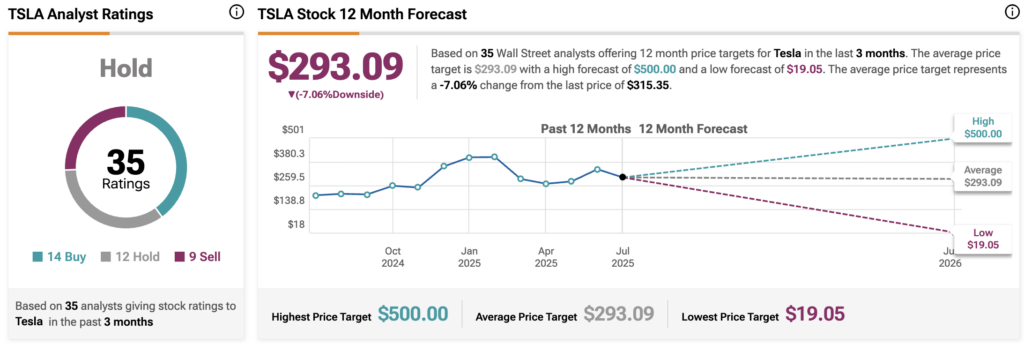Elon Musk’s disdain for LiDAR has long been public—he once famously called it “a crutch” and “lame.” As a result, Tesla (TSLA) decided to rely solely on cameras for autonomous driving, which have seen immense scrutiny. But with competitors like Waymo and Volkswagen (DE:VOW3) (VWAGY) embracing full sensor stacks and reporting smoother results, the performance gap is becoming harder to ignore.
Elevate Your Investing Strategy:
- Take advantage of TipRanks Premium at 50% off! Unlock powerful investing tools, advanced data, and expert analyst insights to help you invest with confidence.
Tesla Bets on Vision. The Real-World Results Are Mixed
Tesla’s robotaxi rollout in Austin is now underway. Built entirely on vision-based autonomy, Tesla’s vehicles avoid radar and LiDAR completely. The system depends on cameras, neural nets and immense data training to replicate human driving.
However, early rider footage tells a more sobering story. Tesla’s robotaxis have been shown struggling with unprotected left turns, getting confused by lane markings, and hesitating at complex intersections. Some engineers who have tested the vehicles say the system remains far from delivering Level 4 autonomy in real-world conditions.
The reason Tesla chose this route is simple: hardware cost. Omitting LiDAR brings down the price per vehicle, helping Tesla scale faster. But the trade-off in accuracy and safety is now being called into question.
Waymo’s Sensor-Heavy Fleet Shows a Different Kind of Progress
While Tesla strips sensors, Waymo embraces them. Its robotaxis are loaded with high-resolution LiDAR, radar and multiple cameras. This multilayered perception system gives Waymo vehicles an edge in complex environments, especially where camera-only vision might falter.
Waymo is currently operating fully driverless robotaxis in Phoenix and San Francisco. The vehicles navigate construction zones, pedestrians and cyclists without human intervention. More importantly, they are gaining regulatory trust and public confidence at a pace Tesla hasn’t yet matched.
This contrast is becoming a defining fault line in the robotaxi race.
Volkswagen’s New Robotaxi Service Brings Europe into the Fight
Volkswagen has now entered the arena with its own LiDAR-equipped robotaxi service, launching first in Hamburg. The company is working with Mobileye (MBLY) to bring Level 4 autonomous capabilities to its all-electric ID. Buzz — a modern, all-electric reimagining of the classic VW microbus.
Unlike Tesla, VW is building its system with regulatory buy-in and long-term infrastructure partnerships. The vehicles use a fusion of LiDAR, radar and vision sensors to deliver consistent performance across different road conditions. With Germany’s strong regulatory framework and public transportation culture, Volkswagen’s program could scale quickly.
The launch in Hamburg is seen as a model for how legacy automakers may gain ground through careful deployment and strict compliance.
Tesla’s Minimalist Sensor Approach Faces Growing Investor Scrutiny
Tesla’s lofty valuation continues to hinge on future expectations tied to its autonomous driving ambitions. In particular, Elon Musk has claimed that the rollout of robotaxi services could eventually add trillions of dollars to the company’s market cap.
But those ambitions remain largely aspirational. Tesla’s camera-only system is still in limited testing and has struggled to gain widespread regulatory approval or consumer trust. Meanwhile, LiDAR-based systems — like those used by Waymo and Volkswagen’s Mobileye-equipped vehicles — have gained traction precisely because they offer more reliable detection in complex environments.
That growing trust in sensor-heavy solutions is raising questions about whether Tesla’s bet on a camera-only path is technologically viable in the near term. Tesla’s success will depend on how robotaxi competitors rack up real-world mileage and city approvals. If they do it well, then Tesla risks falling behind — not just in deployment, but in the narrative of safety and readiness that increasingly drives investor confidence.
Is Tesla a Buy, Sell, or Hold?
According to TipRanks, Tesla currently holds a “Hold” consensus rating from 35 Wall Street analysts. Of those, 14 analysts rate the stock a Buy, 12 recommend Hold, and nine suggest Sell. The average 12-month price target for Tesla is $293.09, representing a 7.06% downside from its last closing price.


















